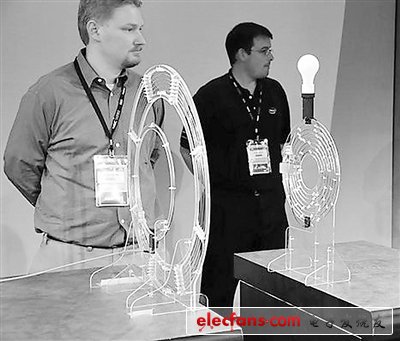Wireless charging, as its name suggests, is a technology that uses air as a medium to transfer power without the aid of metal wires. Nowadays, wireless charging has started from some low-power and low-power electronic products such as smart phones and MP3s, and has gradually developed into high-power electrical equipment. In the civilian sector, Fulton, Energizer, Apple, Nokia, Samsung and other internationally renowned manufacturers have invested heavily in research and development of wireless charging technology. The number of members of the International Wireless Charging Alliance has increased from the first dozen to more than one hundred now. Some experts predict that by 2015, the number of devices supporting wireless charging in the world will increase to more than 100 million. It is foreseeable that an era of wireless charging is coming.

Picture: Two mobile phones are charging with a wireless charging pad
In the military field, the military powers headed by the United States are also scrambling to develop wireless charging technology. It is said that the US Defense Advanced Research Projects Agency has invested $5 million to develop wireless charging technology, initially setting the wireless charging distance to 50 feet (about 15 meters). It is conceivable that as the technology matures and the distance is extended, the weapons and equipment on the battlefield will be freed from the constraints of the wires and the distance, and the maneuverability and continuous combat capability will be greatly enhanced. Soldiers go out on duty or fight, no longer have to carry a bunch of chargers and data lines, not to worry that GPS devices, radio stations, etc. can not work because there is no power. They only need to carry a wireless rechargeable battery with them, no matter where they are at the base or on the battlefield.
Novelty technology has a hundred years of history
To this day, many of us have thought that this is a novel technology when we first heard about wireless charging technology, and even felt a bit ridiculous. In fact, as early as more than 100 years ago, wireless charging technology has emerged. Nikola Tesla, a scientific genius in the late 19th and early 20th centuries, produced a "Tesla coil" that was later called the legend. This current transmitter, wound by a brass coil, produces ultra-high voltage, low current and high frequency power for wireless transmission of electrical energy over a certain area. Although this great invention, which might have changed the world, was eventually dead because of the low transmission efficiency and high risk factor, it opened the door for the world.
Wireless charging four "horse" parallel
As technology advances, scientists have finally verified the feasibility of wireless charging and made major breakthroughs in technology. At present, there are four main types of relatively mature wireless charging technologies: electromagnetic induction, radio waves, electromagnetic resonance, and photoelectric conversion.
Electromagnetic induction technology: Electromagnetic induction technology is currently the most common wireless power transmission method. It inducts current from each other through the coils at the transmitting end and the receiving end, thereby transferring energy from the transmitting end to the receiving end. However, due to the large amount of energy loss caused by the magnetic field radiating in all directions, the transmission efficiency is low, and it is usually only suitable for low-power electronic products that are "sticking" to each other, such as electric toothbrushes, smart phones, cameras, and the like.
Radio wave technology: Traditionally, radio waves are only suitable for transmitting information and are not suitable for transmitting energy. In fact, radio waves, as an electromagnetic wave, can also transmit energy by itself, while also penetrating the air. The radio wave technology mainly uses a power transmitter to transmit radio waves carrying energy, captures radio waves in the air through a miniature high-efficiency receiver, converts radio wave energy into direct current, and charges batteries of different electronic devices.

Figure 1: Successful use of electromagnetic resonance technology to power a bulb
Electromagnetic resonance technology: It mainly uses the "resonance" principle of physics, that is, two objects with the same vibration frequency can transmit energy efficiently. It usually uses a copper coil as an electromagnetic resonance device. When the charger sends out an electromagnetic wave of a certain frequency, a magnetic field resonance is formed between the coil of the power transmitting side and the receiving inductor coil, thereby realizing efficient transmission of electric energy. This is why a cup ruptures when a singer sings at the same frequency as the cup. In 2007, the MIT research team used electromagnetic resonance technology to successfully "catch" the electromagnetic waves, enabling the supply of a 60-watt bulb that is two meters away.
Photoelectric conversion technology: mainly uses laser as a carrier to transfer energy to a destination and then convert it into electric energy, thereby realizing long-distance wireless transmission of energy. Recently, a new laser charging system jointly developed by Lockheed Martin and Laser Power has utilized this principle. It is said that this technology has been tested for wind tunnel flight on a small drone called "Large Walker" used by the US Special Forces. Tests show that the battery capacity of the drone has been effectively improved, flight time can reach more than 48 hours, flight life capacity is increased by 24 times, greatly increasing the time for performing tasks.
This battery is for replacing Lead-Acid Battery, it has the standard appearance and size as well as capacity, but longer cycle life and high energy and good charge and discharge performance.
Capacity:100AH/150AH/180AH/200AH/250AH.
Voltage:12.8V, cycle life is more than 2000 times, also can customize the capacity.
Lead-Acid Replacement Battery(LiFePo4)
Lead-Acid Battery,Lead-Acid Replacement Battery,Lifepo4 Lead Acid Replacement,Lead-Acid Replacement Battery(Lifepo4),12 Volt Battery Backup,Renewable Energy Bank
Shenzhen Enershare Technology Co.,Ltd , https://www.enersharepower.com